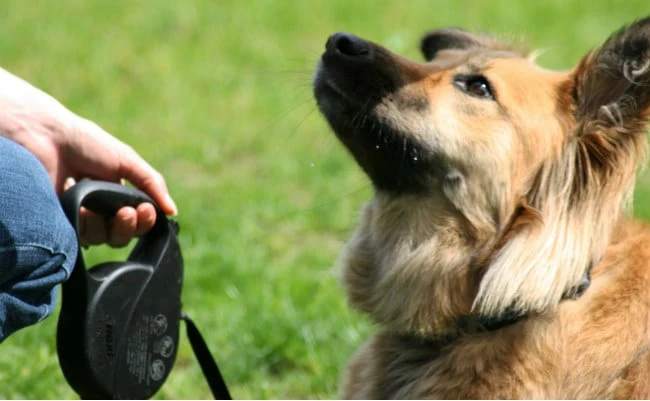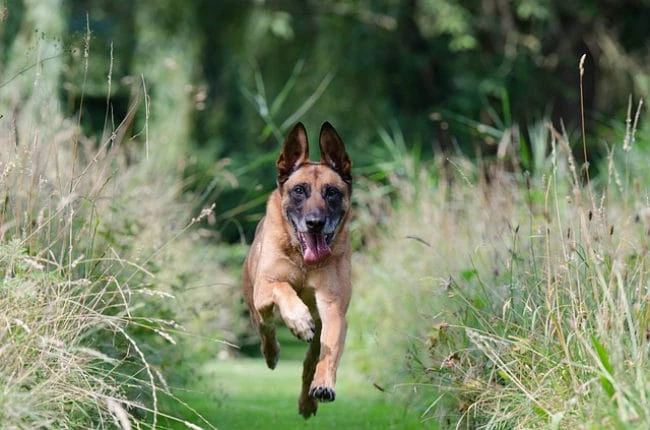5 Basic Commands You Should Teach Your Dog First

Your dog doesn’t have to become an obedience champion to become a well-behaved, enjoyable pet. A few simple commands, which can be learned in any basic obedience class or at home, can turn the friskiest puppy or most excitable dog into a model companion.
Command #1: Teaching Your Dog To Come When Called
Coming when called is an essential skill for a well-trained dog, and it’s often the easiest command to teach. Stand a few feet away from your dog, and, in a pleasant voice, say, “Come, Fido” or “Come here, boy.” Reward correct behavior with praise or a treat. Gradually build up to longer distances and make sure the dog will obey even without a food reward.
This command is especially helpful if your dog slips his leash or dashes out the open front door into the yard or the street. It’s the most important command for ensuring your pet’s safety.
Eventually try to practice this command even when a major distraction (another person, a cat, a squirrel, loud noises) is competing for your dog’s attention. If he comes to you even when his attention is drawn toward something else, you know he has reliably learned this command.
Here is a great video on how to teach your dog to come by using clicker training. The below video focuses on puppies, but you can absolutely use this same method for any age dog.
Command #2: How To Train Your Dog To Sit
It’s easier to introduce your dog to new people if he has good manners. Sitting while he meets a new person definitely exhibits good manners. This command is especially important for large dogs and for excitable ones that are prone to jump up on people.
Clearly and firmly say “sit” while gently pressing your dog’s behind toward the floor. Reward with praise and a treat. After a few times, you should no longer have to press down on his behind.
Some dogs respond better if the command is accompanied by a clicking sound such as snapped fingers. Some respond better when you also make steady eye contact. Experiment to find what works best for your dog, and repeat short training sessions until your pet will reliably sit even when he’s excited or distracted and even without a food reward.
Any time your dog comes over to you to be petted, you can also make him sit before you will pet him. This will consistently show him that sitting generates positive attention from humans.
As I’m a huge fan of clicker training, so here’s another video on how to use clicker training to effectively teach your dog to sit. Even if you don’t want to use clicker training for anything else, clicker training is probably the fastest and most effective way to teach your dog to sit. Just watch in the below video as a dog who has never learned the “sit” command gets trained before your eyes!
Command #3: Off
Not to be confused with the “down” command, which means “lie down,” this command tells your dog to get off of something he shouldn’t be on: the sofa, the bed, or even a person.
To teach your pet this command, be ready the next time he jumps up on furniture. Gently guide him back onto the floor while saying “off,” and reward him (with praise, a treat, or both) once he’s on the floor. Be prepared to repeat this as often as needed while he’s learning not to get onto any off-limits furniture. In the below video, you’ll learn a great technique to teach your dog both the “up” and “off” commands at the same time.
If you’re dog is friendly, excitable, and prone to jump up on people, also be ready to enforce this training whenever you have visitors or when your dog is meeting new people in a public place. Guide the dog away from the person, getting all four paws back on the ground, while giving the “off” command. Then follow with “sit” and plenty of praise. Ask other people not to pet him until he has stopped jumping up. When you’re first teaching your dog to stop jumping up on people, you may want to make sure your dog is on a leash, even indoors, when meeting new people. That way, you have much more control over your dogs movements. Here’s an awesome video on how to teach your dog to stop jumping up on people.
Special Tip For Puppy Owners – New puppies love to jump up and meet people and most of us think it’s adorable (because it IS adorable!). The problem is, new puppies begin to associate jumping up when they meet new people. When they are puppies, it’s cute because they are jumping up on our shins, but many of those little puppies turn into big dogs and it doesn’t become so cute anymore. By allowing your puppy to jump up on people at a young age, you are essentially training him or her that it’s ok to do. So begin training your puppy to stop jumping on people as soon as you can.
Command #4: Wait or Leave It
Does you dog start gobbling his food before you’ve even finished pouring it into the bowl? Does he rush through doors as soon as they open? The “wait” command can make those situations easier and calmer.
To teach “wait,” you’ll need treats or kibble. This one is great to teach at meal time. Have the dog sit, and place a treat or a couple pieces of kibble on the floor several inches in front of him. Say “wait.” If your dog moves toward the food, scoop it up and repeat the process.
Be ready to praise and reward your pet as soon as he gets the hang of this one, even if he stays seated for only a moment or two. You can say, “Good boy. Get it” to signal when he is free to take the food. Gradually build up to a longer wait time, and then begin trying this command when you’re leaving the house, getting your pet out of the car, or any other time you need him to wait before running ahead.
Command #5: Heel
A dog who constantly pulls at his leash makes walking with him frustrating rather than enjoyable. The solution is to teach your pet the “heel” command. “Heeling” is walking beside you on a slack leash rather than straining ahead.
To teach this command, use a 6-foot leash. Later, you may want to use a longer lead, but they’re not the best option for initial training sessions. You can teach this command by walking in the street, in your yard, or even in the aisles of a local pet supply store. Wherever you choose, you should be able to walk straight ahead for several yards, and you need room to quickly turn and go the other direction.
Walk with your dog while giving the “heel” command. Praise him if we walks beside you without tugging. As soon as he pulls ahead, firmly say “no,” then turn and walk in the opposite direction. With dogs who really enjoy pulling and tugging, you may find yourself constantly spinning in circles as you head in the opposite direction yet again. Be patient. Teach this command for only a few minutes at a time until your pet catches on. If needed, switch to a lead that gently fits around the dog’s muzzle. Dogs often don’t mind if a collar tugs at their neck, but they dislike the feeling of a lead tightening around their mouth every time they pull.
Here is another great way to teach your dog to heel using…. you guessed it! Clicker training!
You can always teach your dog additional commands. You may choose useful ones such as “stay” and “down” and adorable ones such as “shake” and “roll over.” But these five basics will lay the groundwork for an enjoyable, well-behaved pet who is ready to learn anything else you want to teach him.
Written By: By Ashley Salter



